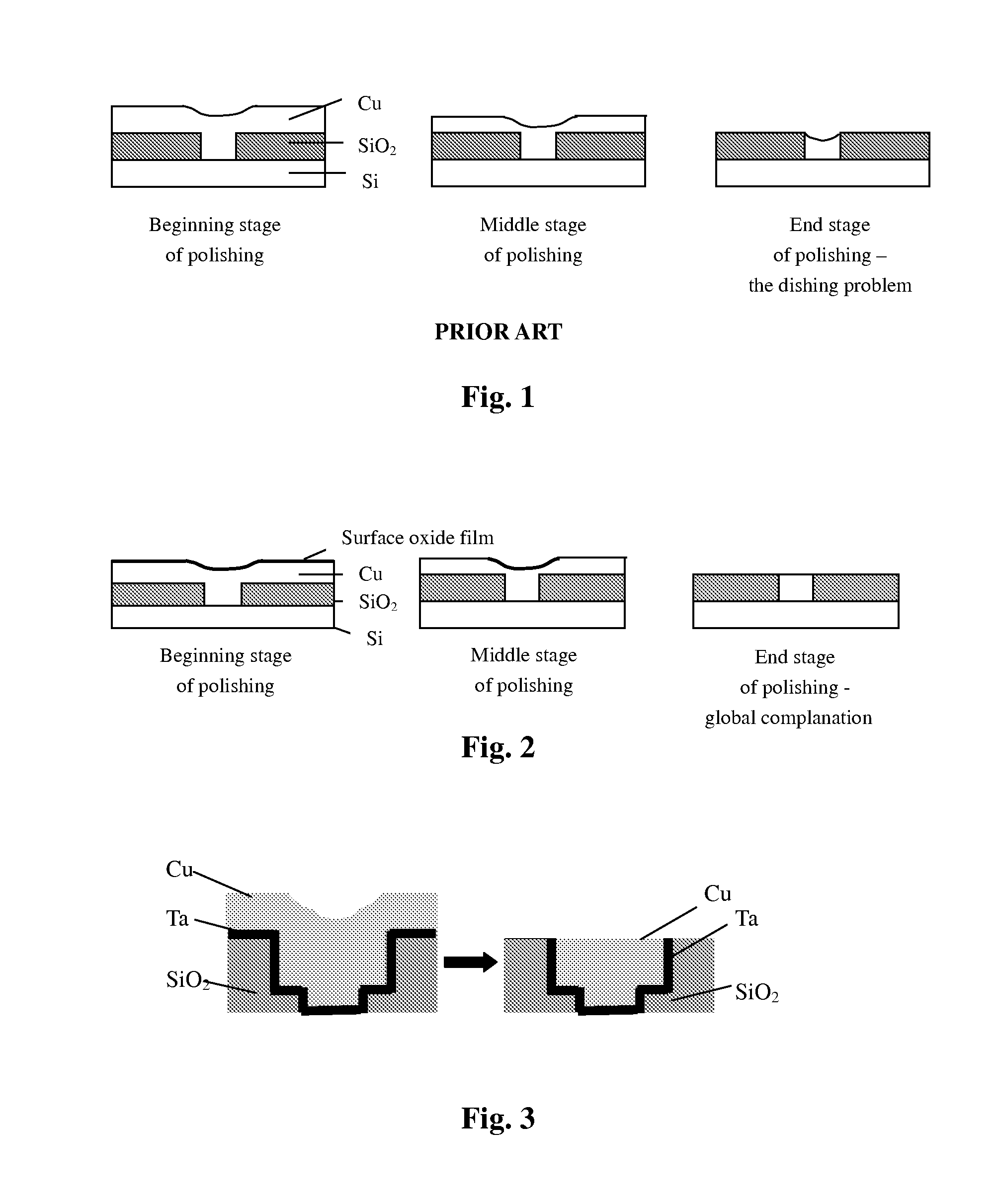Method for controlling the dishing problem associated with chemical-mechanical planarization (CMP) during manufacture of copper multilayer interconnection structures in ultra large-scale integrated circuits (ULSI)
a multi-layer interconnection structure and chemical-mechanical technology, applied in lapping machines, other chemical processes, manufacturing tools, etc., can solve the problems of increasing electrical noise, adversely affecting the power characteristics of components, unstable adhesion ability between copper and dielectric layers, etc., and achieves stable chelating effect on several different metals.
- Summary
- Abstract
- Description
- Claims
- Application Information
AI Technical Summary
Benefits of technology
Problems solved by technology
Method used
Image
Examples
example 1
[0042] The polishing slurry and the polishing condition of the initial polishing and the final polishing are as follows.
[0043] For the initial polishing stage of Cu-CMP, the slurry characteristics are as follows: the SiO2 sol abrasive size is 40 nm, the SiO2 initial concentration is 40 wt. %, the proportion of SiO2 abrasive to deionized water is 1:1, the FA / O I surfactant concentration is 50 ml / L of the slurry, the FA / O chelating agent concentration is 50 ml / L of the slurry, the pH ranges from 9.5-11.5, and the oxidant H2O2 concentration is 30 ml / L of the slurry. The polishing condition: pressure is 200 g / cm2, the slurry flow is 200 ml / min, the rotation speed is 100 rpm, the temperature is 30° C., the polishing speed ranges between 200-1100 nm / min, and the polishing time is 1-5 min. The initial polishing speeds are exemplified in Table 1.
TABLE 1The initial polishing speeds#1#2#3#4#5#6(Cu)(Cu)(Ta)(Ta)(SiO2)(SiO2)Before CMP (μm)738160.5460.5378.52468.532After-CMP (μm)657460.5060.50...
example 2
[0048] The polishing slurry and the polishing condition of the initial polishing and the final polishing are as follows.
[0049] For the initial polishing stage of Cu-CMP, the slurry characteristics are as follows: the SiO2 sol abrasive particle size is 20 nm, the initial SiO2 concentration is 50 wt. %, the proportion of the SiO2 abrasive to deionized water is 1:3, the FA / O I surfactant concentration is 80 ml / L of the slurry, the FA / O chelating agent concentration is 60 ml / L of the slurry, the pH is in the range from about 9.5 to about 11.5, and the oxidant H2O2 concentration is 30 ml / L of the slurry. The polishing conditions are as follows: the polishing pressure is 250 g / cm2, the slurry flow is 200 ml / min, the rotation speed is 120 rpm, the temperature is 40° C., and the polishing time is 1-5 min.
[0050] For the final polishing stage of Cu-CMP, the slurry characteristics are as follows: the SiO2 sol abrasive particle size is15 nm, the initial SiO2 concentration is 40 wt. %, the pro...
PUM
| Property | Measurement | Unit |
|---|---|---|
| Temperature | aaaaa | aaaaa |
| Fraction | aaaaa | aaaaa |
| Fraction | aaaaa | aaaaa |
Abstract
Description
Claims
Application Information
 Login to View More
Login to View More - R&D
- Intellectual Property
- Life Sciences
- Materials
- Tech Scout
- Unparalleled Data Quality
- Higher Quality Content
- 60% Fewer Hallucinations
Browse by: Latest US Patents, China's latest patents, Technical Efficacy Thesaurus, Application Domain, Technology Topic, Popular Technical Reports.
© 2025 PatSnap. All rights reserved.Legal|Privacy policy|Modern Slavery Act Transparency Statement|Sitemap|About US| Contact US: help@patsnap.com



